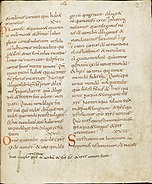The Vulgate (/ˈvʌlɡeɪt, -ɡət/)[a] is a late-4th-century Latin translation of the Bible. It is largely the work of Jerome who, in 382, had been commissioned by Pope Damasus I to revise the Vetus Latina Gospels used by the Roman Church. Later, of his own initiative, Jerome extended this work of revision and translation to include most of the books of the Bible.
The Vulgate became progressively adopted as the Bible text within the Western Church. Over succeeding centuries, it eventually eclipsed the Vetus Latina.[1] By the 13th century it had taken over from the former version the designation versio vulgata (the "version commonly used"[2]) or vulgata for short.[3] The Vulgate also contains some Vetus Latina translations that Jerome did not work on.[4]
The Catholic Church affirmed the Vulgate as its official Latin Bible at the Council of Trent (1545–1563), though there was no authoritative edition of the book at that time.[5] The Vulgate did eventually receive an official edition to be promulgated among the Catholic Church as the Sixtine Vulgate (1590), then as the Clementine Vulgate (1592), and then as the Nova Vulgata (1979). The Vulgate is still currently used in the Latin Church. The Clementine edition of the Vulgate became the standard Bible text of the Roman Rite of the Catholic Church, and remained so until 1979 when the Nova Vulgata was promulgated.
Cite error: There are <ref group=lower-alpha> tags or {{efn}} templates on this page, but the references will not show without a {{reflist|group=lower-alpha}} template or {{notelist}} template (see the help page).
- ^ "vetuslatina.org". www.vetuslatina.org. Retrieved 10 July 2024.
- ^ T. Lewis, Charlton; Short, Charles. "A Latin Dictionary | vulgo". Perseus Digital Library. Retrieved 5 October 2019.
- ^ Ackroyd, Peter R.; Evans, C. F.; Lampe, Geoffrey William Hugo; Greenslade, Stanley Lawrence (1963). The Cambridge History of the Bible: Volume 1, From the Beginnings to Jerome. Vol. 1. Cambridge University Press. ISBN 978-0-521-09973-8.
- ^ "Vulgate | Description, Definition, Bible, History, & Facts | Britannica". www.britannica.com. 14 June 2024. Retrieved 10 July 2024.
- ^ Metzger, Bruce M. (1977). The Early Versions of the New Testament. Oxford: Clarendon Press. p. 348.

